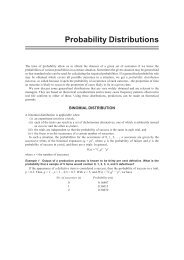International-Business-Dr-R-Chandran-E-book
International-Business-Dr-R-Chandran-E-book
International-Business-Dr-R-Chandran-E-book
You also want an ePaper? Increase the reach of your titles
YUMPU automatically turns print PDFs into web optimized ePapers that Google loves.
93<br />
<strong>International</strong> <strong>Business</strong>- <strong>Dr</strong>. R. <strong>Chandran</strong><br />
of the unpaid invoice; proof of dispatch and a signed declaration from<br />
the beneficiary stating that payment has not been received by the due<br />
date and therefore reimbursement is claimed by letter of credit. The<br />
<strong>International</strong> Chamber of Commerce publishes rules for operating<br />
standby letter of credit ISP98- <strong>International</strong> Standby Practices.<br />
Revolving Letter of Credit: The revolving credit is used for regular<br />
shipments of the same commodity to the same importer. It can revolve<br />
in relation to time or value. If the credit is time revolving once utilized<br />
it is reinstated for further regular shipments until the credit is fully<br />
drawn. If the credit revolves in relation to value once utilized and paid<br />
the value can be reinstated for further drawings. The credit must state<br />
that it is a revolving letter of credit and it may revolve either<br />
automatically or subject to certain provisions. Revolving letters of<br />
credit are useful to avoid the need for repetitious arrangements for<br />
opening or amending letters of credit.<br />
Transferable Letter of Credit: A transferable letter of credit is one<br />
in which the exporter has the right to request the paying, or<br />
negotiating bank to make either part, or all, of the credit value<br />
available to one or more third parties. This type of credit is useful for<br />
those acting as middlemen especially where there is a need to finance<br />
purchases from third party suppliers.<br />
Back to Back Letter of Credit: A back to back letter of credit can be<br />
used as an alternative to the transferable letter of credit. Rather than<br />
transferring the original letter of credit to the supplier, once the letter<br />
of credit is received by the exporter from the opening bank, that letter<br />
of credit is used as security to establish a second letter of credit drawn<br />
on the exporter in favour of his importer. Many banks are reluctant to<br />
issue back-to-back letters of credit due to the level of risk to which<br />
they are exposed, whereas a transferable credit will not expose them<br />
to higher risk than under the original credit.<br />
Uniform Customs and Practice for Documentary Credit<br />
(UCPDC): Most letters of credit are subject to UCP 600 which are the<br />
universally recognized set of rules governing the use of the<br />
documentary credits in international trade. UCP were originally<br />
formulated in 1993 by the <strong>International</strong> Chamber of Commerce (ICC)<br />
and last updated in 2003 ICC publication. All definitions and general<br />
documentary requirements referred to in this briefing are in<br />
accordance with UCP 600 unless otherwise stated (it should be<br />
remembered that in some instances this may differ from national law).<br />
Only for Private Circulation





